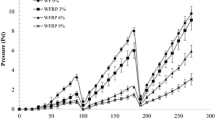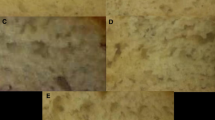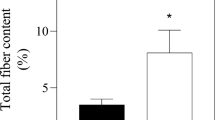Abstract
The aim of the present study was to incorporate Pseudophycis bachus powder (cod fish powder—CFP) into bread with different levels (5%, 10% and 15%), and evaluate the physical (moisture, volume), technological (texture and colour), nutritional (amino acid content, protein and starch digestibility), and nutraceutical (total phenolic content (TPC) and antioxidant capacity) properties of the fortified breads compared with a control bread. Partial substitution of wheat flour with CFP improved the nutritional and nutraceutical properties of bread. The results showed that fortification of wheat flour with CFP reduced the predictive glycaemic index of bread. Additionally, bread with CFP showed an increased (p < 0.05) protein digestibility and protein quality in terms of an increased corrected amino acid score (CAAS). Moreover, total phenolic content and antioxidant capacity of bread samples were increased with CFP addition. Thus, enrichment of bread with CFP may be a significant alternative to the food industry to deliver nutritionally enriched bread.



Similar content being viewed by others
References
Coelho MS, Salas-Mellado MM (2015) Effects of substituting chia (Salvia hispanica L.) flour or seeds for wheat flour on the quality of the bread. LWT Food Sci Technol 60:729–736. https://doi.org/10.1016/j.lwt.2014.10.033
Liu W, Brennan M, Serventi L, Brennan C (2017) Buckwheat flour inclusion in Chinese steamed bread: potential reduction in glycemic response and effects on dough quality. Eur Food Res Technol 243:727–734. https://doi.org/10.1007/s00217-016-2786-x
Dziki D, Rozylo R, Gawlik-Dziki U, Swieca M (2014) Current trends in the enhancement of antioxidant activity of wheat bread by the addition of plant materials rich in phenolic compounds. Trends Food Sci Technol 40:48–61. https://doi.org/10.1016/j.tifs.2014.07.010
Gawlik-Dziki U, Świeca M, Dziki D et al (2013) Quality and antioxidant properties of breads enriched with dry onion (Allium cepa L.) skin. Food Chem 138:1621–1628. https://doi.org/10.1016/j.foodchem.2012.09.151
Buresova I, Tokar M, Marecek J et al (2017) The comparison of the effect of added amaranth, buckwheat, chickpea, corn, millet and quinoa flour on rice dough rheological characteristics, textural and sensory quality of bread. J Cereal Sci 75:158–164. https://doi.org/10.1016/j.jcs.2017.04.004
Turfani V, Narducci V, Durazzo A et al (2017) Technological, nutritional and functional properties of wheat bread enriched with lentil or carob flours. LWT Food Sci Technol 78:361–366. https://doi.org/10.1016/j.lwt.2016.12.030
Coda R, Varis J, Verni M et al (2017) Improvement of the protein quality of wheat bread through faba bean sourdough addition. LWT Food Sci Technol 82:296–302. https://doi.org/10.1016/j.lwt.2017.04.062
Fagundes G, Rocha M, Salas-Mellado M (2018) Improvement of protein content and effect on technological properties of wheat. Food Res 2:221–227
Seczyk Ł, Swieca M, Gawlik-Dziki U (2016) Effect of carob (Ceratonia siliqua L.) flour on the antioxidant potential, nutritional quality, and sensory characteristics of fortified durum wheat pasta. Food Chem 194:637–642. https://doi.org/10.1016/j.foodchem.2015.08.086
Dalton A, Wolmarans P, Witthuhn RC et al (2009) A randomised control trial in schoolchildren showed improvement in cognitive function after consuming a bread spread, containing fish flour from a marine source. Prostaglandins Leukot Essent Fat Acids 80:143–149. https://doi.org/10.1016/j.plefa.2008.12.006
Kadam SU, Prabhasankar P (2010) Marine foods as functional ingredients in bakery and pasta products. Food Res Int 43:1975–1980. https://doi.org/10.1016/j.foodres.2010.06.007
Desai A, Brennan MA, Brennan CS (2018) The effect of semolina replacement with protein powder from fish (Pseudophycis bachus) on the physicochemical characteristics of pasta. LWT Food Sci Technol 89:52–57. https://doi.org/10.1016/j.lwt.2017.10.023
Lin J, Zhou W (2018) Role of quercetin in the physicochemical properties, antioxidant and antiglycation activities of bread. J Funct Foods 40:299–306. https://doi.org/10.1016/j.jff.2017.11.018
AACC (2000) Approved methods of the American association of cereal chemists, 10th edn. American Association of Cereal Chemistis, St. Paul, MN, USA
Lu BMA, Serventi L et al (2016) How the inclusion of mushroom powder can affect the physicochemical characteristics of pasta. Int J Food Sci Technol 51:2433–2439. https://doi.org/10.1111/ijfs.13246
Brennan MA, Menard C, Roudaut G, Brennan CS (2012) Amaranth, millet and buckwheat flours affect the physical properties of extruded breakfast cereals and modulates their potential glycaemic impact. Starch Stärke 64:392–398. https://doi.org/10.1002/star.201100150
Heems D, Luck G, Fraudeau C, Verette E (1998) Fully automated precolumn derivatization, on-line dialysis and high- performance liquid chromatographic analysis of amino acids in food, beverages and feedstuff. J Chromatogr A 798:9–17. https://doi.org/10.1016/S0021-9673(97)01007-8
FAO/WHO (2007) Protein and amino acid requirements in human nutrition. Rep Jt WHO/FAO/UNU Expert Consult WHO Tech Rep Ser 935 World Heal Organ Geneva, Switzerland
Hsu HW, Vavak DL, Satterlee LD, Miller GA (1977) A multienzyme technique for estimating protein. J Food Sci 7:1269–1273
Sarwar G (1997) The protein digestibility–corrected amino acid score method overestimates quality of proteins containing antinutritional factors and of poorly digestible proteins supplemented with limiting amino acids in rats. J Nutr 127:758–764
Hossain AKMM, Brennan MA, Mason SL et al (2017) The effect of astaxanthin-rich microalgae “Haematococcus pluvialis” and wholemeal flours incorporation in improving the physical and functional properties of cookies. Foods 6:57. https://doi.org/10.3390/foods6080057
Phongthai S, D’Amico S, Schoenlechner R, Rawdkuen S (2016) Comparative study of rice bran protein concentrate and egg albumin on gluten-free bread properties. J Cereal Sci 72:38–45. https://doi.org/10.1016/j.jcs.2016.09.015
Sanz-Penella JM, Wronkowska M, Soral-Smietana M, Haros M (2013) Effect of whole amaranth flour on bread properties and nutritive value. LWT - Food Sci Technol 50:679–685. https://doi.org/10.1016/j.lwt.2012.07.031
Reshmi SK, Sudha ML, Shashirekha MN (2017) Starch digestibility and predicted glycemic index in the bread fortified with pomelo (Citrus maxima) fruit segments. Food Chem 237:957–965. https://doi.org/10.1016/j.foodchem.2017.05.138
Villarino CBJ, Jayasena V, Coorey R et al (2015) The effects of lupin (Lupinus angustifolius) addition to wheat bread on its nutritional, phytochemical and bioactive composition and protein quality. Food Res Int 76:58–65. https://doi.org/10.1016/j.foodres.2014.11.046
Lu ZH, Donner E, Liu Q (2018) Effect of roasted pea flour/starch and encapsulated pea starch incorporation on the in vitro starch digestibility of pea breads. Food Chem 245:71–78. https://doi.org/10.1016/j.foodchem.2017.10.037
Brennan MA, Derbyshire E, Tiwari BK, Brennan CS (2012) Enrichment of extruded snack products with coproducts from chestnut mushroom (Agrocybe aegerita) production: interactions between dietary fiber, physicochemical characteristics, and glycemic load. J Agric Food Chem 60:4396–4401. https://doi.org/10.1021/jf3008635
Sayed Ahmad B, Talou T, Straumite E et al (2018) Protein bread fortification with cumin and caraway seeds and by-product flour. Foods 7:17–28. https://doi.org/10.3390/foods7030028
Masure HG, Wouters AGB, Fierens E, Delcour JA (2019) Impact of egg white and soy proteins on structure formation and crumb firming in gluten-free breads. Food Hydrocoll 95:406–417. https://doi.org/10.1016/j.foodhyd.2019.04.062
Franco D, Munekata PES, Agregán R et al (2020) Application of pulsed electric fields for obtaining antioxidant extracts from fish residues. Antioxidants 9:1–14. https://doi.org/10.3390/antiox9020090
Garcia-Segovia P, Igual M, Martinez-Mozo J (2020) Physicochemical properties and consumer acceptance of bread enriched with alternative proteins. Foods 9:933
Sahagún M, Benavent-Gil Y, Rosell CM, Gómez M (2020) Modulation of in vitro digestibility and physical characteristics of protein enriched gluten free breads by defining hydration. LWT Food Sci Technol. https://doi.org/10.1016/j.lwt.2019.108642
Acknowledgement
This research was supported by postgraduate Lincoln University, Christchurch, New Zealand and authors kindly acknowledge the project funding department of Lincoln University for financial support.
Author information
Authors and Affiliations
Corresponding author
Ethics declarations
Conflict of interest
The authors declare no conflict of interest.
Compliance with Ethics requirements
This research article does not contain any studies with human or animal subjects.
Additional information
Publisher's Note
Springer Nature remains neutral with regard to jurisdictional claims in published maps and institutional affiliations.
Rights and permissions
About this article
Cite this article
Desai, A.S., Beibeia, T., Lu, X. et al. How the inclusion of cod (Pseudophycis bachus) protein enriched powder to bread affects the in vitro protein and starch digestibility, amino acid profiling and antioxidant properties of breads. Eur Food Res Technol 247, 1177–1187 (2021). https://doi.org/10.1007/s00217-021-03699-w
Received:
Revised:
Accepted:
Published:
Issue Date:
DOI: https://doi.org/10.1007/s00217-021-03699-w




